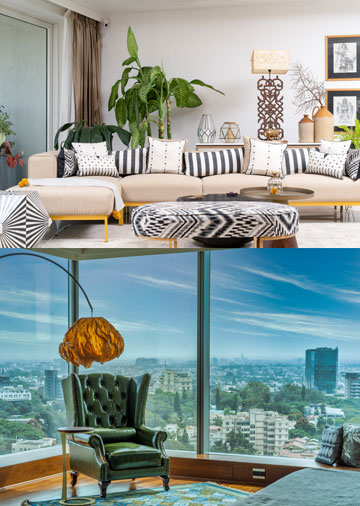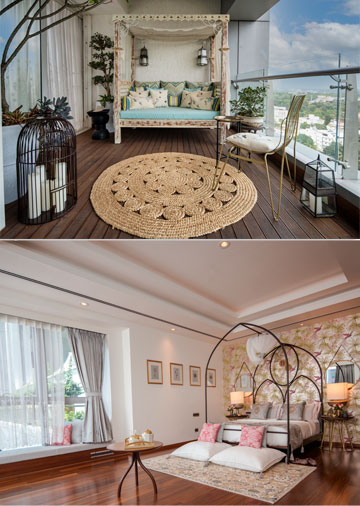
The Home and the World
- Home Decor
- |
- 16 January 2021
- Priya Kumari Rana
After a decade of making their mark in fashion – from prêt and couture for women to menswear – Bengaluru-based luxury design maison House of Three now ventures into interiors, with a spectacular weekend house belonging to India’s youngest billionaire, whose every corner evokes a certain emotion. Strongly artistic, and with a focus on mindful, sustainable, and inclusive materials and products, House of Three Creative Director Sounak Sen Bharat tells us about his journey from fashion to interiors, and how it’s all about tapping into the poet or artist in all of us.
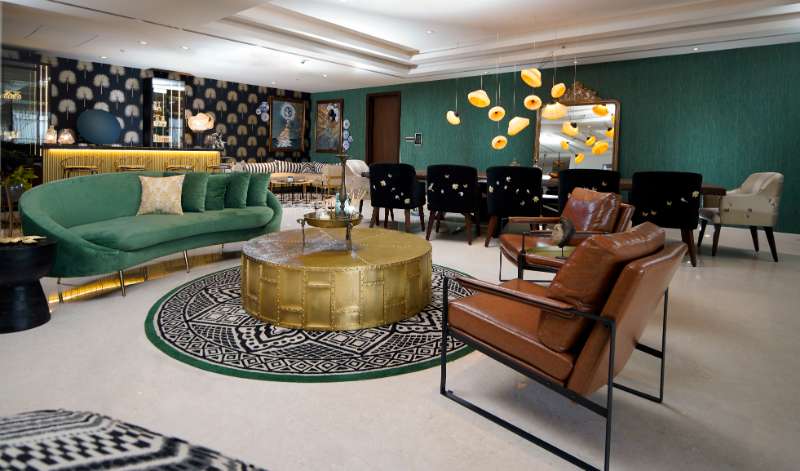 Eclectic and plush and with an Indian heart at House of Three - Nikhil Kamath's house
Eclectic and plush and with an Indian heart at House of Three - Nikhil Kamath's house
What was it like to make the transition from fashion to interiors, at House of Three? When did you start your brand?
The transition from fashion to interiors was fluid and organic. Interiors was always on our mind right from the inception of the label in 2008. It was always a part of our vision board to organically expand across segments and categories over time. As a self-funded company that started as a prêt label and added on Custom Couture, Diffusion, Bespoke Menswear, and Home over time, the next natural progression was to embark upon a journey into interiors. Our objective was to create a belief system and a way of life that manifested itself across all areas of life – from fashion, to home, to living and wellbeing.
Design to us is about solving someone else’s problem, while leaving behind an inherent signature that helps people identify your sensibility. At a physical level, a human body and a physical space are both three-dimensional entities. You adorn the human body externally, while you fill up a room/space from the inside. The elements of design that govern what you do or how you approach them are still the same. To identify the need, translate certain emotions and psychological needs into tangible physical products, using the elements of design of proportions, balance, functionality, and aesthetic signature.
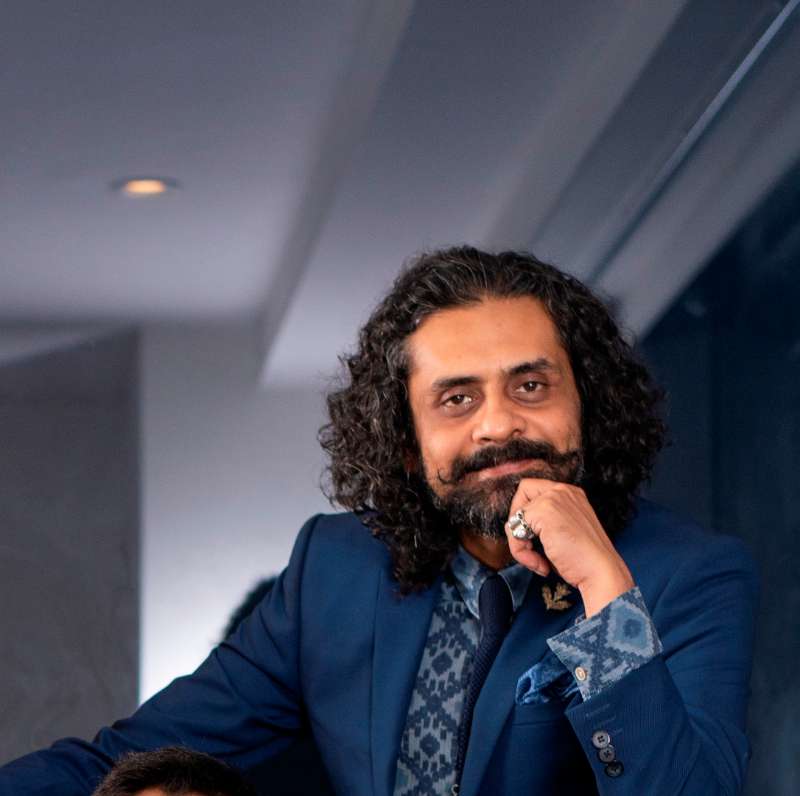 Sounak Sen Bharat, Creative Director, and Co-founder, House of Three
Sounak Sen Bharat, Creative Director, and Co-founder, House of Three
What is your underlying philosophy for your brand?
House of Three gets its name from a simple thought. It is clothing for the mind, body and soul. That was the starting point. Everything evolves. Nothing is a constant. Life evolves, you get wiser, more compassionate, more mindful as you grow older, and so does your vision of your label, which is only an extension of your own belief systems. Our core brand promise too has changed and evolved over time. What started as a prêt label based on the aesthetics of a marriage of contrasts, drawing from anthropology, art, architecture, geometry, music and culture, evolved to make sustainability its core value. We started working with various weaving clusters across India, combining contrasting tastes and cultures to create a language of acceptance, harmony and unity in diversity, at a brand promise level. We also felt that we could play a role in embracing, restoring, and strengthening the role of our handloom weavers. They still weave on the same looms and the same techniques that were designed more than a thousand years ago. Their ways are sustainable, self-sufficient and mindful of the environment. Why then should an average Indian’s wardrobe not substantially comprise of our own handlooms?
From there the journey embraced the ideologies of collective consciousness with an eye to give back. The lingering question has always been “what can we do to help”, no matter how big-scale a problem may be. So today in addition to our core verticals of fashion and interiors, we also have a consultancy wing that works collaboratively with organized corporate houses to create affordable sustainable solutions. In a country of 1.3 billion people, doing a niche luxury sustainable brand proposition that caters only to 1 percent of the population, does nothing on ground zero to reduce our gross carbon footprint. We were therefore quick to engage with Future Style Labs when they approached us to consult with them to create the brand Ancestry.
As another example, we have opened up our own ecommerce site to other like-minded fellow designers. In a pandemic and a recession, where everyone is reluctant to spend or visit stores, a lot of small businesses have had to downsize or shut down. By the time people could create their own respective ecommerce channels and come up in the search engine, a year may pass, considering that these take a certain investment, for which a lot of designers may not currently have the bandwidth. So we thought we could humbly share our platform with them.
We are constantly curating and adding beautiful labels across sustainable mindful fashion, home, living, and wellbeing, while also expanding our own distribution and reach across the categories we work with. Our philosophy is to live and let live. We approach our business not only from the lens of our own selfish growth. Our approach is more socialistic and it comes from a place of empathy and sharing.
About the interiors – you were already selling crockery and art – where do you source these from, for example the works of Sindhur Reddy?
When we started curating labels, artists, and so on we started from within our circles. Charity begins at home as they say. Sindhur is a promising young photographer who has shot two of our seasonal campaigns (Sealdah Lucknow Express and Ajna). He can very clearly distinguish between commercial work, his own personal artistic pursuits, and also that space where the two can meet fluidly. He travels to document different cultures in all their wholeness. From festivals, to food to weddings. We felt he needed a voice, and people needed to see the world through his beautiful mind and eyes.
The same goes for Minimal Indian crockery. Adrita, who owns the brand, was a junior colleague during my Madura Garments days. She too embraced her journey as an entrepreneur in due course. Her products were simple, humble, sustainable and evoked an emotion of tranquility. In due course we approached her to sell her products with us and there was no looking back thereafter.
In addition, we would just simply approach designers whose work we admired, whether we knew them personally or not. Our proposition was simple and clean without any hidden catches. Sell with us at much lesser commissions than multi-brand online platforms, so onboarding them was never an issue.
Pop-ups were an important revenue stream for us till a couple of years back. We would meet such interesting small businesses doing such beautiful products! We found a lot of brands there too.
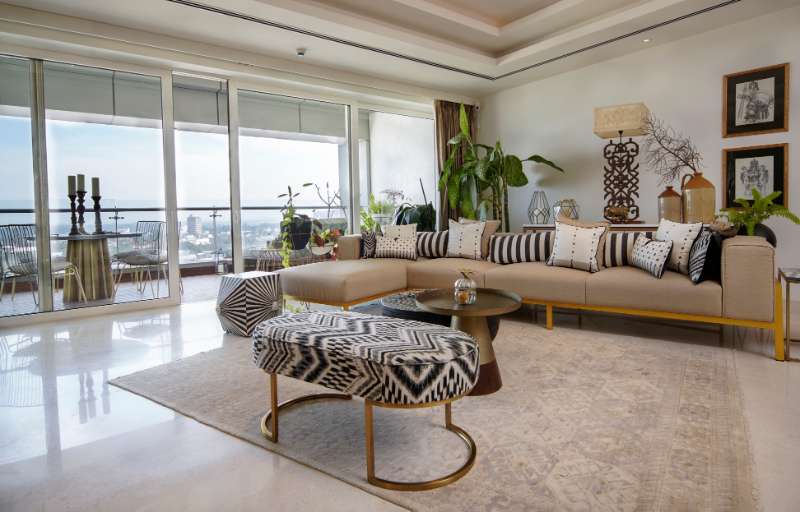 Furnishings that are sourced from independent producers for House of Three - Nikhil Kamath's house
Furnishings that are sourced from independent producers for House of Three - Nikhil Kamath's house
When it comes to interiors – what is it that you aim to do when you take over a space?
A home is your sacred space. It is an extension of you – your values, your ethics, your personality, tastes, likes, dislikes, expressions, and lifestyle choices. It is so personal. It is therefore very personal to us too. Our job is to simply translate these intangible virtues into tangible physical spaces, and while doing so with versatility and adaptability, leave behind our own little stamp.
Simultaneously, we work with the small and micro sector, the crafts sector, the handloom sector for upholsteries to custom create/source/upcycle/repurpose products. The core thought is to use a business opportunity to enable and uplift everyone involved – the client, the vendors, the brands, the craftsmen, the weavers… the approach is that of a collective wellbeing.
And while we are at it, our subconscious awareness and determination to execute every idea with the most minimal pressure on the environment as possible. Source local, source handcrafted, reduce the carbon footprint. We would discourage clients to import Italian marble for instance. Yes one can afford it, but imagine the carbon footprint it would leave behind. At some point one must stop thinking selfishly and be more inclusive and mindful of others. So why not go back into our old wisdom and revive sustainable techniques that are not just mindful, but handcrafted, personal, and just drop-dead luxurious! The only luxury one has is time. Anything that is made meticulously by hand, taking all the time necessary, is the purest form of luxury one can discern.
We also look into the minutest of details at a personal level with a genuine attitude to serve and improve our clients’ cumulative quality of life – things that no one does. We don’t just decorate spaces, we instill a soul to it in a sense. We would study your lifestyle and even stack up your fridge on the basis of your personal tastes and palette. We would plug in activities (and hence spaces that allow such activities) like yoga or painting on canvases, so as to motivate you to find a more balanced and harmonious lifestyle that is focused towards holistic wellbeing. We would fix you up with a nutritionist, or an art teacher, or a yoga instructor, depending on what gaps in life our clients want to fill.
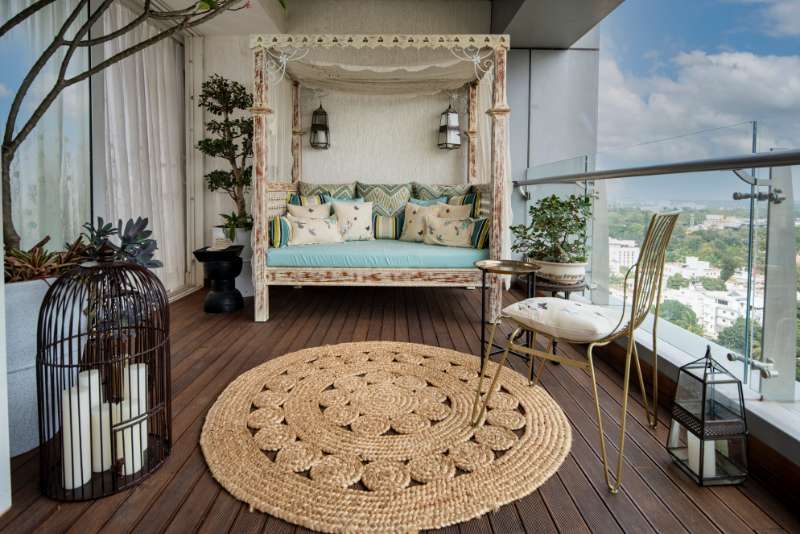 A balcony with a rafia mat and antique-finish sofa at Nikhil Kamath's home - House of Three
A balcony with a rafia mat and antique-finish sofa at Nikhil Kamath's home - House of Three
What were the advantages of working with a space like Nikhil Kamath’s (Co-Founder of Bengaluru-based broking platform Zerodha)? What did he want his house to reflect?
The space was in a way a disadvantage. We couldn’t do any structural changes. Not even wall or ceiling light fixtures! The sprawling apartment is a glass box quite literally, with only the living space opening up into a wide outdoor deck.
The advantage however was Nikhil himself. He was a blessing! I keep joking with him, saying that he has spoilt me silly by giving me a 100 percent free hand with the project. Where would I find another like him? His brief was simple. He told me just two things.
The space will be a weekend stay for the whole family, including his elder brother, sister-in-law, their son and the senior Kamaths. Also that he was starting True Beacon and this den would be used to entertain his clients.
He loves nature and he asked me to use a lot of greens wherever possible to give him a sense of grounding and calm, considering that he was atop a sky scraper inside a glass box, far away from the soil and earth.
That was my starting point. I then detailed out the sketches keeping in mind his personality.
When I shared the plan with him he instantly agreed on all the drawings. When I told him of my vision that I wanted to work only with small businesses that were only Made in India, and that I wanted to use this opportunity to in a way provide some much needed relief and respite to as many people as possible, he instantly agreed without batting an eyelid. When I told him that I would be sourcing some art from graduating students of Baroda Art School, in addition to whatever else I make myself or source from other artiest and designers, in order to help some of these kids with some much needed financial relief in the middle of a lockdown, he instantly agreed. He is all of 34 but he has the humility, compassion and the wisdom of an old monk! Very few billionaires exude that ethos of giving back. Very few self-made HNIs have the grounding to value their past foundations. His approach to money is so different from anyone I have seen. He thinks of it as energy. Just like thoughts, if you let out a thought to the universe with the purest intentions, it comes true. He approaches money the same way. He doesn’t think of it as scarce, nor does he have any fear of losing it. He uses it to uplift others directly or indirectly without any insecurity of any kind. He is a special soul. He is also flamboyant but in a uniquely quit, composed way. He is a people’s person but is super soft spoken. He has an undeniable charm about him. So all these nuances come across beautifully in his Kingfisher Towers apartment in Bengaluru.
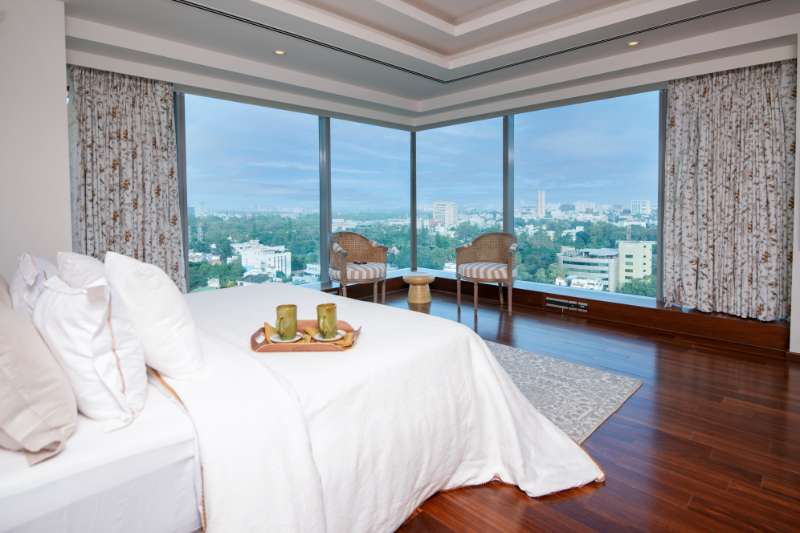 Minimalist touches to a bedroom overlooking the city of Bengaluru at Nikhil Kamath's home - House of Three
Minimalist touches to a bedroom overlooking the city of Bengaluru at Nikhil Kamath's home - House of Three
When you consult with your client, what is the most important question you ask them?
Oh, there are many! They say that there is a dormant artist or a poet within everyone. By that logic there is a designer within everyone too. It’s just that most people haven’t tapped into that side and are therefore not very good at expressing these faculties. We ask questions that get into their psyche and help us to translate their thoughts into tangible spaces, using colours, forms, textures, materials, art, greenery etc. Our design process is also inclusive and encourages our clients to engage more personally. After all, it is their home, so it must have their own personal touch.
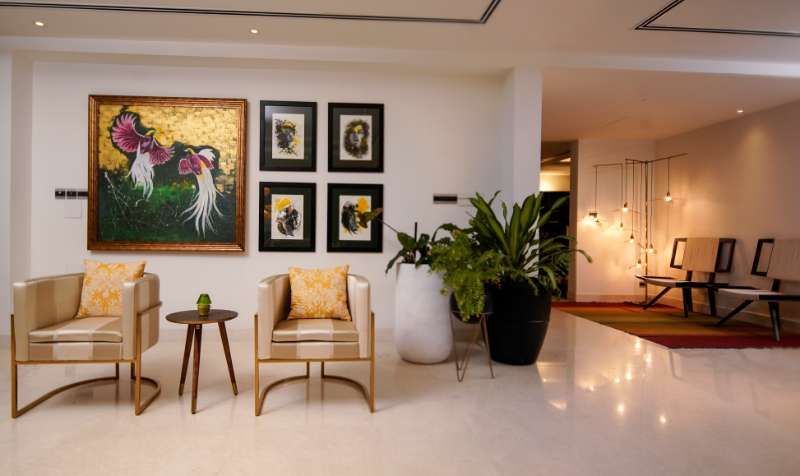 Paintings by upcoming artists adorn the walls at Nikhil Kamath's home - House of Three
Paintings by upcoming artists adorn the walls at Nikhil Kamath's home - House of Three
I notice there is a touch of eclecticism and art in the interiors – from the bold art on the walls, to the wallpaper to the lighting – where do you source your wallpaper from? And the lighting?
Both the wallpapers are imported. These were the only two items in the entire home that were imported. India still doesn’t have the technology to print (embossed) gold pigment on wallpaper, unless its handpainted. The whole project came about through the lockdown. Most printers hadn’t reopened operations when we were sourcing and placing orders. So we had to go with a UK company to be able to finish up within the timelines.
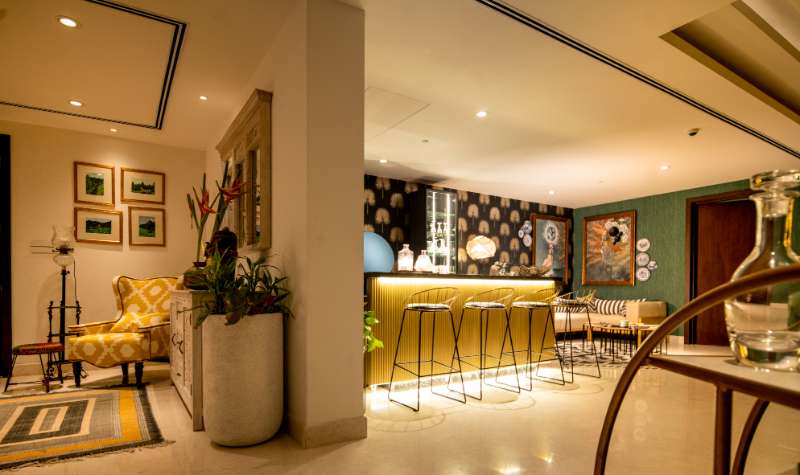 Ikat furnishings, rugs made locally create a put together look at Nikhil Kamath's home - House of Three
Ikat furnishings, rugs made locally create a put together look at Nikhil Kamath's home - House of Three
What kind of furniture do you like to use – you have done a blend of different styles – what is it that makes you put an entire look together?
The idea was to create a versatile space, where different rooms, nooks, and corners evoked different moods and emotions. We don’t feel the same way all day… we have a myriad of moods and emotions in just a single day. So why should one’s home be any different? The more personal spaces were therefore designed in a way that made you feel calm and relaxed, whereas the more public/entertaining spaces were sharper and more flamboyant. We used multiple influences and married them seamlessly together. From the Baroque to mid-century modern, to Art Deco… You will see elements of all the above put seamlessly together and then stitched up with a soul that is glaringly Indian, to create that eclectic vibe.
There is so much in this world! Each culture has its own aesthetic identity with the most fascinating back stories from history. India alone has so much diversity! I find it suffocatingly restricting to just stick to a one-dimensional monotonous visual identity. The more you explore, the more you absorb and learn – enriching yourself and others around you. However, the most important process in design is that of filtration or funnelling. You explore all you want, but eventually funnel it to have a certain signature handwriting, despite the versatility. Striking that balance is the most important process in design.
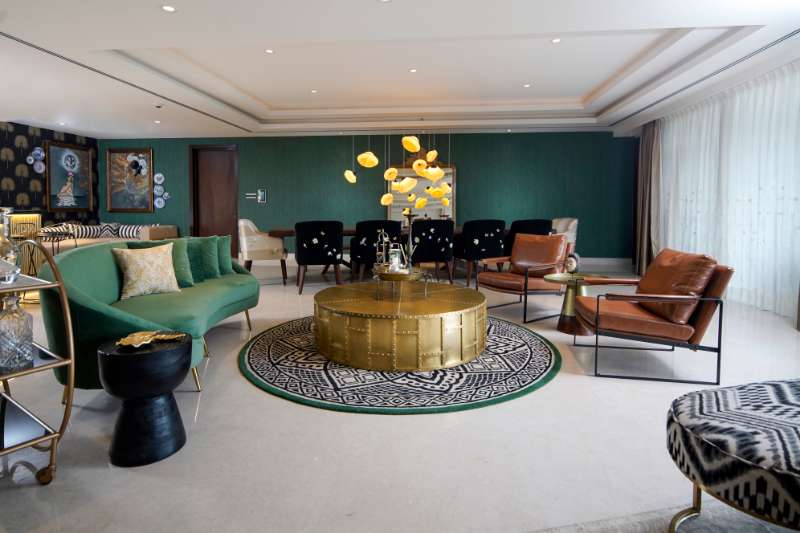 Almost all the furniture and fabrics are made in India at House of Three - Nikhil Kamath's house
Almost all the furniture and fabrics are made in India at House of Three - Nikhil Kamath's house
What colour palette do you like – I can tell you go for bold colours...
In my personal capacity/taste, colour isn’t my primary forte. If you see our seasonal fashion collections over the years, we stick to conventional palettes of pastels and rich jewel tones in addition to the classical black, white, and earthy tones. I design clothes and spaces like a stylist or a curator. And then I bind that eclectic language with a very tight colour palette. That helps to make spaces or clothes/forms look cleaner and more articulate.
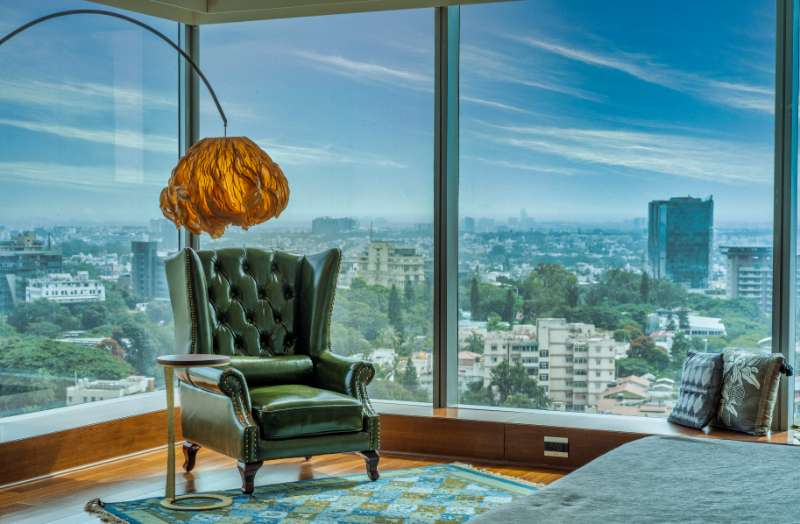 A view to the world - a stunning corner encased in glass walls at Nikhil Kamath's home - House of Three
A view to the world - a stunning corner encased in glass walls at Nikhil Kamath's home - House of Three
Are you working on homes across the country – what are some of the projects that you have currently (you can describe them if you don't wish to name them)?
We are to start executing two very interesting projects from mid-January and beginning of February.
A 4,500 sq feet private rooftop in a duplex apartment, where the owners want to transform that space into an entertainment spot, which also acts as a space to chill for them in their personal time. We are creating a tropical forest of sorts, with Bali as an inspiration, that has allocated areas for entertaining, kitchen-cum-bar, service, lounge, a water body and even a guest bedroom with its own private open-air shower and Jacuzzi. The idea is to create a space that is calming during the day (with wellbeing and self-introspection in mind) and at night, with the use of smart lighting, have it transform into a space with a high-energy vibe.
A young family who wants to redo their interiors from scratch. They have a five-year-old bright boy who is a talented drummer already, so the space has to exude a certain energy that is encouraging of multi-dimensional learning. Certain spaces will be changed structurally to make a more fluid indoor-outdoor space where nature plays an integral role of being the fourth family member. The approach will remain the same, but in this case, the colours would be far more muted and calming than Nikhil’s home. We will also be mindful that no objects in the house should have any sharp edges, and the floors aren’t slippery, so that the child can move as freely as he wants, without any fear of any accidents. I’m also going to do an art workshop where the whole family will paint canvases along with me. These would then adorn their own walls for years to come.
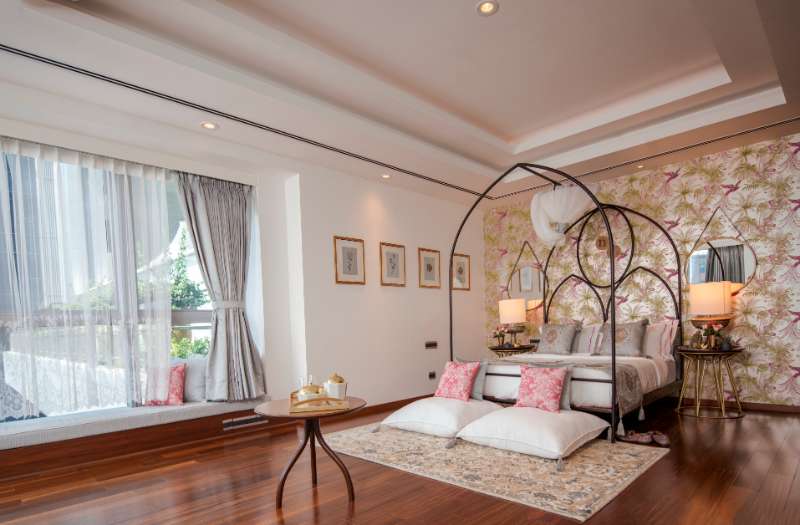 A bedroom that is minimalistic yet rife with detailing at Nikhil Kamath's home - House of Three
A bedroom that is minimalistic yet rife with detailing at Nikhil Kamath's home - House of Three
Are you interested in working on commercial projects as well – such as hotels or offices?
For 2021, our focus is homes. We are also in the process of meeting various sustainable architects and builders in order to offer our services B2B. We can make any home anywhere in India, but our focus is the South as of now. We are a small company and we are more interested in quality over quantity. It’s easier to expand zone-wise as against running all over the place. We don’t want to dilute our USP. Do less, with uncompromised integrity and grow organically. Build a network of likeminded artists, craftsmen, entrepreneurs, architects, product designers, light designers along the way…
I’d rather just make four homes and one restaurant or a bar/pub next year, that people love and talk about for years to come; that inspires other design firms to think sustainably, inclusively, mindfully from a lens of holistic wellbeing, than dilute our proposition by doing more numbers. Less is more. Slow is the new black.
Once we get our solid grounding in this new vertical, we shall then scale up starting 2022. I also want to start my own experiential luxury home stay where one can come and experience our values, thoughts, and sensitive approach to life and living, where we are mindful of Nature, inclusive and exude a spirit of collective consciousness and wellbeing.
FOLLOW US ON INSTAGRAM

Lifestyle Insider is a kind of junction point, connecting people with diverse interests that touch on the more luxurious aspects of lifestyle – fashion, design, travel, food and spirits, art, watches and jewellery, cars, yachts, and aviation, and technology. People today don’t fit into boxes and categories. In our individual ways, we are interested in diverse themes, products, and the challenges that face our world today. You will judge how well this effort of mine caters to your passions and proclivities.
Lifestyle Insider is a showcase of all that is beautiful and luxe. Behind every creation, is a designer, chef, entrepreneur, or a design maison. I have delved into my own appreciation for objetsde luxe that I have admired over the years – be it a love of fashion from the world’s top Parisian and Italian fashion maisons and their ’90s muses, or the care that goes into sari and Indian textile collections in my own family. Growing up on four continents, as the daughter of a former Indian Ambassador, I’ve seen a remarkable array of historic places and met a myriad people. My aim is to bring my world view into this website, a curation of what I find particularly stunning, unique, and newsworthy.
It’s an exciting time for brands all over the world. With change comes opportunity. With the global ‘reset’ and uncertainty on many fronts, there is a chance to write a new script. Let’s be those pioneers.
A bit about me:
A luxury and fashion journalist with 25 years of experience in publishing and magazine journalism, I have edited some of India’s top fashion and luxury magazines. I got my BA in Comparative Literature from UC Berkeley, and went on to receive my Master’s in English and French from the University of Strasbourg, France. I have also studied German and Film. I live in Gurugram, India, and look forward to once again exploring our world with a new-found freedom.
Priya Kumari Rana
Founder and EditorContact Us
Mail us @ lifestyleinsiderindia@gmail.com



